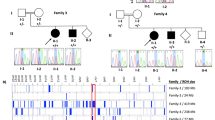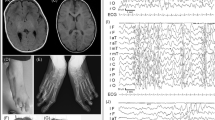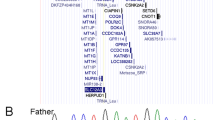Abstract
LISSENCEPHALY (agyria-pachygyria) is a human brain malformation manifested by a smooth cerebral surface and abnormal neuronal migration1,2. Identification of the gene(s) involved in this disorder would facilitate molecular dissection of normal events in brain development3. Type 1 lissencephaly occurs either as an isolated abnormality or in association with dysmorphic facial appearance in patients with Miller–Dieker syndrome4,5. About 15% of patients with isolated lissencephaly and more than 90% of patients with Miller–Dieker syndrome have microdeletions in a critical 350-kilobase region in chromosome 17p13.3 (ref. 6). These deletions are hemizygous, so haplo-insufficiency for a gene in this interval is implicated. Here we report the cloning of a gene (LIS-1, lissencephaly-1) in 17p13.3 that is deleted in Miller–Dieker patients. Non-overlapping deletions involving either the 5' or 3' end of the gene were found in two patients, identifying LIS-l as the disease gene. The deduced amino-acid sequence shows significant homology to β-subunits of heterotrimeric G proteins, suggesting that it could possibly be involved in a signal transduction pathway crucial for cerebral development.
This is a preview of subscription content, access via your institution
Access options
Subscribe to this journal
Receive 51 print issues and online access
$199.00 per year
only $3.90 per issue
Buy this article
- Purchase on Springer Link
- Instant access to full article PDF
Prices may be subject to local taxes which are calculated during checkout
Similar content being viewed by others
References
Aicardi, J. Int. Pediatr. 4, 118–126 (1989).
Dobyns, W. B. Neurol. Clin. 7, 89–105 (1989).
Barth, P. G. Can. J. Neurol. Sci. 14, 1–16 (1987).
Miller, J. Q. Neurology 13, 841–850 (1963).
Dieker, H. et. al. The Lissencephaty Syndrome. The Clinical Delineation of Birth Defects II: Malformation Syndromes 1–64 (National Foundation March of Dimes, New York, 1969).
Ledbetter, S. A., Kuwano, A., Dobyns, W. B. & Ledbetter, D. H. Am. J. hum. Genet. 50, 182–189 (1992).
Duronio, R. J., Gordon, J. I. & Boguski, M. S. Proteins 13, 41–56 (1992).
Lee, C. C. et al. Science 239, 1288–1291 (1988).
Guillemot, F., Billault, A. & Auffray, C. Proc. natn. Acad. Sci. U.S.A. 86, 4594–4598 (1989).
Guzzetta, V. et al. Genomics 13, 551–559 (1992).
Dobyns, W. B., Curry, C. J. R., Hoyme, H. E., Turlington, L. & Ledbetter, D. H. Am. J. hum. Genet. 48, 584–594 (1991).
Ledbetter, D. H. et al. Proc. natn. Acad. Sci. U.S.A. 86, 5136–5140 (1989).
Leberer, E., Dignard, D., Hougan, L., Thomas, D. Y. & Whiteway, M. EMBO J. 11, 4805–4813 (1992).
Birnbaumer, L. Cell 71, 1069–1072 (1992).
Simon, M. I., Strathmann, M. P. & Gautam, N. Science 252, 802–808 (1991).
Gilman, A. G. A. Rev. Biochem. 56, 615–649 (1987).
Kleuss, C., Scherubl, H., Hescheler, J., Schultz, G. & Wittig, B. Science 259, 832–834 (1993).
Iniguez-Lluhi, J. A., Simon, M. I., Robishaw, J. D. & Gilman, A. G. J. biol. Chem. 267, 23409–23417 (1992).
Bourne, H. R. & Nicholl, R. Cell 72, 65–76 (1993).
Igarashi, M., Strittematter, S. M., Vartanian, T. & Fishman, M. C. Science 259, 77–79 (1993).
Nishimoto, I. et al. Nature 362, 75–79 (1993).
Keleher, C. A., Redd, M. J., Schultz, J., Carlson, M. & Johnson, A. D. Cell 68, 709–719 (1992).
Orikin, S. H. & Nathan, D. G. New Engl. J. Med. 295, 710–714 (1976).
Altschul, S. F., Gish, W., Miller, W., Myers, E. W. & Lipman, D. J. J. molec. Biol. 215, 403–410 (1990).
Bilofsky, H. S. & Burks, C. Nucleic Acids Res. 16, 1861–1864 (1988).
van Tuinen, P., Rich, D. C., Summers, K. M. & Ledbetter, D. H. Genomics 1, 374–381 (1987).
Sambrook, S., Fritisch, E. I. & Maniatis, T. Molecular Cloning: A Laboratory Manual (Cold Spring Harbor Laboratory Press, New York, 1989).
Kuwano, A., Ledbetter, S. A., Dobyns, W. B., Emanuel, B. S. & Ledbetter, D. H. Am. J. hum. Genet. 49, 707–714 (1991).
Kuwano, A. et al. Hum. molec. Genet. 1, 417–425 (1992).
Author information
Authors and Affiliations
Rights and permissions
About this article
Cite this article
Reiner, O., Carrozzo, R., Shen, Y. et al. Isolation of a Miller–Dicker lissencephaly gene containing G protein β-subunit-like repeats. Nature 364, 717–721 (1993). https://doi.org/10.1038/364717a0
Received:
Accepted:
Issue Date:
DOI: https://doi.org/10.1038/364717a0
This article is cited by
-
Lis1 slows force-induced detachment of cytoplasmic dynein from microtubules
Nature Chemical Biology (2024)
-
How mechanisms of stem cell polarity shape the human cerebral cortex
Nature Reviews Neuroscience (2022)
-
Clinical and neuroimaging findings in patients with lissencephaly/subcortical band heterotopia spectrum: a magnetic resonance conventional and diffusion tensor study
Neuroradiology (2022)
-
Properties of the epileptiform activity in the cingulate cortex of a mouse model of LIS1 dysfunction
Brain Structure and Function (2022)
-
Enhanced homologous recombination by the modulation of targeting vector ends
Scientific Reports (2020)
Comments
By submitting a comment you agree to abide by our Terms and Community Guidelines. If you find something abusive or that does not comply with our terms or guidelines please flag it as inappropriate.



